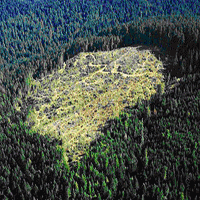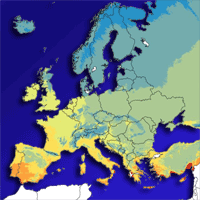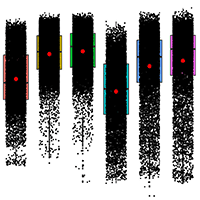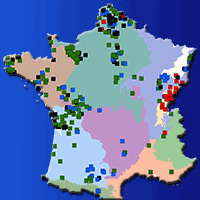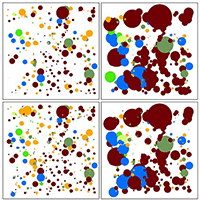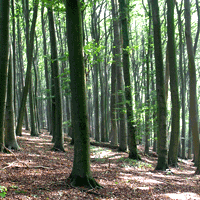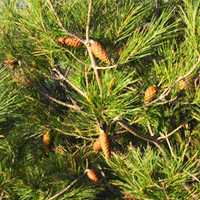In Mediterranean regions, climate change increasingly affect tree species distributions. Conifer forests under continuing disturbance show a more rapid shift to dominance by beech and other temperate broadleaves. Thus, there is an urgent need to conserve coniferous vegetation to avoid local extinction. Gap opening has profound effects on the structure and dynamics of most forests and may represent a sustainable way to restore coniferous ecosystems in Mediterranean habitats. What kind of artificial canopy opening is the most sustainable and effective means for restoring coniferous ecosystem functions? We explored the efficacy of artificial gaps in regeneration and dynamics of coniferous in Mediterranean environment. We examined how regeneration of different tree species is associated with soil environmental conditions and how gaps of different sizes influence the ecology and management of Mediterranean forest. Specifically, we analyzed gap disturbance in silver fir and black pine stands, as they dominate central and southern Italian forests. We demonstrated a specificity between gap size and coniferous species regeneration, indicating that small gaps (about 200 m2) favor silver fir regeneration, while black pine, depending on its subspecies, regenerates both in small and medium gaps (about 500 m2). Further, we found that gap characteristics (age and shape) and suitable substrate availability are the primary factors affecting seedling establishment. Our results provide functional information to design a silvicultural system useful to manage the natural regeneration of Mediterranean forest minimizing the environmental and visual impact.
Keywords
, , , ,
Citation
Muscolo A, Settineri G, Bagnato S, Mercurio R, Sidari M (2017). Use of canopy gap openings to restore coniferous stands in Mediterranean environment. iForest 10: 322-327. - doi: 10.3832/ifor1983-009
Academic Editor
Andrea Cutini
Paper history
Received: Jan 13, 2016
Accepted: Sep 17, 2016
First online: Feb 23, 2017
Publication Date: Feb 28, 2017
Publication Time: 5.30 months
© SISEF - The Italian Society of Silviculture and Forest Ecology 2017
Open Access
This article is distributed under the terms of the Creative Commons Attribution-Non Commercial 4.0 International (https://creativecommons.org/licenses/by-nc/4.0/), which permits unrestricted use, distribution, and reproduction in any medium, provided you give appropriate credit to the original author(s) and the source, provide a link to the Creative Commons license, and indicate if changes were made.

Breakdown by View Type
(Waiting for server response...)
Article Usage
Total Article Views: 49250
(from publication date up to now)
Breakdown by View Type
HTML Page Views: 40646
Abstract Page Views: 3300
PDF Downloads: 4172
Citation/Reference Downloads: 55
XML Downloads: 1077
Web Metrics
Days since publication: 3181
Overall contacts: 49250
Avg. contacts per week: 108.38
Article Citations
Article citations are based on data periodically collected from the Clarivate Web of Science web site
(last update: Mar 2025)
Total number of cites (since 2017): 21
Average cites per year: 2.33
Publication Metrics
by Dimensions ©
Articles citing this article
List of the papers citing this article based on CrossRef Cited-by.
(1)
Albanesi E, Gugliotta OI, Mercurio R (2005)Effects of gap size and within-gap position on seedlings establishment in silver fir stands. iForest 1 (1): 55-59.
CrossRef |
Gscholar
(2)
Barik SK, Pandey HN, Tripathi RS, Rao P (1992)Microenvironmental variability and species-diversity in treefall gaps in a subtropical broadleaved forest. Vegetatio 103: 31-40.
Online |
Gscholar
(3)
Bianchi L, Bottacci A, Calamini G, Maltoni A, Mariotti B, Quilghini G, Salbitano F, Tani A, Zoccola A, Paci M (2011)Structure and dynamics of a beech forest in a fully protected area in the northern Apennines (Sasso Fratino, Italy). iForest 4: 136-144.
CrossRef |
Gscholar
(4)
Bottalico F, Travaglini D, Fiorentini S, Lisa C, Nocentini S (2014)Stand dynamics and natural regeneration in silver fir (
Abies alba Mill.) plantations after traditional rotation age. iForest 7: 313-323.
CrossRef |
Gscholar
(5)
Boyden S, Binkley D, Shepperd W (2005)Spatial and temporal patterns in structure, regeneration, and mortality of an old-growth ponderosa pine forest in the Colorado Front Range. Forest Ecology and Management 219: 43-55.
CrossRef |
Gscholar
(6)
Bradshaw FJ (1992)Quantifying edge effect and patch size for multiple-use silviculture: a discussion paper. Forest Ecology and Management 48: 249-264.
CrossRef |
Gscholar
(7)
Brokaw NVL (1985)Treefalls, regrowth and community structure in tropical forests. In: “The Ecology of Natural Disturbance and Patch Dynamics” (Pickett SA, White DC eds). Academic Press, Inc, Orlando, USA, pp. 53-69.
Gscholar
(8)
Burton PJ, Macdonald SE (2011)The restorative imperative: challenges, objectives and approaches to restoring naturalness in forests. Silva Fennica 45: 843-863.
CrossRef |
Gscholar
(9)
Caplat P, Anand M, Bauch C (2008)Interactions between climate change, competition, dispersal, and disturbances in a tree migration model. Theoretical Ecology 1: 209-220.
CrossRef |
Gscholar
(10)
Chumanová-Vávrová E, Cudlín O, Cudlín P (2015)Spatial and temporal patterns of ground vegetation dominants in mountain spruce forests damaged by sulphur air pollution (Giant mountains, Czech Republic). Boreal Environment Research 20: 620-636.
Online |
Gscholar
(11)
Ciancio O, Iovino F, Menguzzato G, Nicolaci A, Nocentini S (2006)Structure and growth of a small group selection forest of Calabrian pine in Southern Italy: a hypothesis for continuous cover forestry based on traditional silviculture. Forest Ecology and Management 224: 229-234.
CrossRef |
Gscholar
(12)
Coates KD, Burton PJ (1997)A gap-based approach for development of silvicultural systems to address ecosystem management objectives. Forest Ecology and Management 99: 337-354.
CrossRef |
Gscholar
(13)
Cutini A, Gamba C, Mercurio R, Modica G, Piovanelli C, Simoncini S (2004)Osservazioni ecologiche su tagli a buche nelle abetine del Parco Nazionale delle Foreste Casentinesi [Ecological observations on small patch cuts in silver fir monocultures in the Casentino Forests National Park (Italy)]. Annali Istituto Sperimentale per la Selvicoltura 31: 27-38. [in Italian]
Gscholar
(14)
Dahir SE, Lorimer CG (1996)Variation in canopy gap formation among developmental stages of northern hardwood stands. Canadian Journal of Forest Research 26: 1875-92.
CrossRef |
Gscholar
(15)
Daniel TW, Helms JA, Baker FS (1979)Principles of silviculture. McGraw-Hill, New York, USA pp. 452.
Online |
Gscholar
(16)
Denslow JS (1980)Gap partitioning among tropical rainforest trees. Biotropica 12: 47-55.
CrossRef |
Gscholar
(17)
Fang J, Lechowicz MJ (2006)Climatic limits for the present distribution of beech (
Fagus L.) species in the world. Journal of Biogeography 33: 1804-1819.
CrossRef |
Gscholar
(18)
Fernández-Ondoño E, Serrano LR, Jiménez MN, Navarro FB, Díez M, Martín F, Fernández J, Martinez FJ, Roca A, Aguilar J (2010)Afforestation improves soil fertility in south-eastern Spain. European Journal of Forest Research 129: 707-717.
CrossRef |
Gscholar
(19)
Gagnon JL, Jokela EJ, Moser WK, Huber DA (2004)Characteristics of gaps and natural regeneration in mature longleaf pine flatwoods ecosystems. Forest Ecology and Management 187: 373-80.
CrossRef |
Gscholar
(20)
Giacobbe A (1958)Prospettive colturali delle foreste appenniniche [Cultural perspectives of the Apennine forests]. Annali Accademia Italiana di Scienze Forestali 7: 241-258. [in Italian]
Gscholar
(21)
Gugliotta OI, Mercurio R (2003)Prime osservazioni su tagli a buche in pinete di pino nero in Abruzzo [Early observations on patch cuts in black pine forest in Abruzzo]. Monti e Boschi 54: 18-21. [in Italian]
Gscholar
(22)
Gugliotta OI, Mercurio R, Albanesi E (2006)Dynamics of natural regeneration in
Pinus laricio stands from southern Apennines (Italy). Forest@ 3: 380-386. [in Italian with English summary]
CrossRef |
Gscholar
(23)
Hamer KC, Hill JK, Benedick S, Mustaffa N, Sherratt TN, Chey VK, Maryati M (2003)Ecology of butterflies in natural and selectively logged forests of northern Borneo: the importance of habitat heterogeneity. Journal of Applied Ecology 40: 150-162.
CrossRef |
Gscholar
(24)
Kneeshaw DD, Bergeron Y (1998)Canopy gap characteristics and tree replacement in the southeastern boreal forest. Ecology 79: 783-794.
CrossRef |
Gscholar
(25)
Lertzman KP (1992)Patterns of gap-phase replacement in a subalpine old-growth forest. Ecology 73: 657-669.
CrossRef |
Gscholar
(26)
Lindner M, Maroschek M, Netherer S, Kremer A, Barbati A, Garcia-Gonzalo J, Seidl R, Delzon S, Corona P, Kolström M, Lexer MJ, Marchetti M (2010)Climate change impacts, adaptive capacity, and vulnerability of European forest ecosystems. Forest Ecology and Management 259: 698-709.
CrossRef |
Gscholar
(27)
Madsen P (1995)Effects of soil water content, fertilization, light, weed competition and seedbed type on natural regeneration of beech (
Fagus sylvatica). Forest Ecology and Management 72: 251-264.
CrossRef |
Gscholar
(28)
Madsen P, Hahn K (2008)Natural regeneration in a beech-dominated forest managed by close-to-nature principles - a gap cutting based experiment. Canadian Journal of Forest Research 38: 1716-1729.
CrossRef |
Gscholar
(29)
MAF/ISAFA (1988)Inventario Forestale Nazionale. Sintesi metodologica e risultati. [Italian National Forest Inventory. Methods and results]. Ministero dell’Agricoltura e delle Foreste. Istituto Sperimentale per l’Assestamento Forestale e per l’Alpicoltura, Trento, Italy, pp. 462. [in Italian]
Gscholar
(30)
Mercurio R (2000)Esperienze e prospettive sull’applicazione del taglio a buche nelle abetine del Parco Nazionale delle Foreste Casentinesi [Experiences and perspectives on the application of small patch cuts treatment in silver fir stands in the Casentino Forests National Park (Italy)]. L’Italia Forestale e Montana 55: 219-230. [in Italian]
Gscholar
(31)
Mercurio R, Spampinato G (2001)Dinamiche della vegetazione in tagli a buche nelle abetine del Parco Nazionale delle Foreste Casentinesi. [Vegetation dynamics in patch cuts in silver fir stands in the Casentino Forests National Park (Italy)]. Informatore Botanico Italiano 33: 215-218. [in Italian]
Gscholar
(32)
Mercurio R, Mallamaci C, Muscolo A, Sidari M (2009)Gap size effects on tree regeneration in afforestations of Black pine (
Pinus nigra Arn.). Forest@ 6: 312-319. [in Italian with English summary]
CrossRef |
Gscholar
(33)
Muscolo A, Sidari M, Mercurio R (2007a)Variations in soil chemical properties and microbial biomass in artificial gaps in silver fir stands. European Journal of Forest Research 126: 59-65.
CrossRef |
Gscholar
(34)
Muscolo A, Sidari M, Mercurio R (2007b)Influence of gap size on organic matter decomposition, microbial biomass and nutrient cycle in Calabrian pine (
Pinus laricio Poiret) stands. Forest Ecology and Management 242: 412-418.
CrossRef |
Gscholar
(35)
Muscolo A, Sidari M, Bagnato S, Mallamaci C, Mercurio R (2010)Gap size effects on above- and below-ground processes in a silver fir stand. European Journal of Forest Research 129: 355-365.
CrossRef |
Gscholar
(36)
Muscolo A, Mallamaci C, Sidari M, Mercurio R (2011)Effects of gap size and soil chemical properties on the natural regeneration in black pine (
Pinus nigra Arn.) stands. Tree and Forestry Science and Biotechnology 5: 65-71.
Online |
Gscholar
(37)
Nyland RD (2002)Silviculture. Concepts and applications. McGraw Hill, Boston, USA, pp. 682.
Gscholar
(38)
Rebertus AJ, Veblen TT (1993)Structure and tree-fall gap dynamics of old-growth
Nothofagus forests in Tierra del Fuego, Argentina. Journal of Vegetation Science 4: 641-654.
CrossRef |
Gscholar
(39)
Ren JY, Kadir A, Yue M (2015)The role of tree-fall gaps in the natural regeneration of birch forests in the Taibai Mountains. Applied Vegetation Science 18: 64-74.
CrossRef |
Gscholar
(40)
Rey F, Berger F (2006)Management of Austrian black pine on marly lands for sustainable protection against erosion (Southern Alps, France). New Forests 31: 535-543.
CrossRef |
Gscholar
(41)
Runkle JR (1982)Patterns of disturbance in some old-growth mesic forests of Eastern North-America. Ecology 63: 1533-1546.
CrossRef |
Gscholar
(42)
Runkle JR (2000)Canopy tree turnover in old-growth mesic forests of eastern North America. Ecology 8: 554-567.
CrossRef |
Gscholar
(43)
Sapkota IP, Tigabu M, Odenm PC (2009)Species diversity and regeneration of old-growth seasonally dry
Shorea robusta forests following gap formation. Journal of Forest Research 20: 7-14.
CrossRef |
Gscholar
(44)
Scarascia-Mugnozza G, Oswald H, Piussi P, Radoglou K (2000)Forests of the Mediterranean region: gaps in knowledge and research needs. Forest Ecology and Management 132: 97-109.
CrossRef |
Gscholar
(45)
Schliemann SA, Bockheim JG (2011)Methods for studying treefall gaps: a review. Forest Ecology and Management 261: 1143-1151.
CrossRef |
Gscholar
(46)
Schnitzer SA, Carson WP (2001)Treefall gaps and the maintenance of species diversity in a tropical forest. Ecology 82: 913-919.
CrossRef |
Gscholar
(47)
Schnitzer SA, Mascaro J, Carson VP (2008)Treefall gaps and the maintenance of plant species diversity in tropical forests. In: “Tropical Forest Community Ecology” (Carson VP, Schnitzer SA eds). Blackwell Publishing, Oxford, UK, pp. 196-209.
Online |
Gscholar
(48)
Seymour RS, White AS, De Maynadier PG (2002)Natural disturbance regimes in northeastern North America - evaluating silvicultural systems using natural scales and frequencies. Forest Ecology and Management 155: 357-367.
CrossRef |
Gscholar
(49)
Smith DM, Larson BC, Kelty MJ, Ashton PMS (1997)The practice of silviculture: applied forest ecology. John Wiley and Sons, New York, USA, pp. 537.
Online |
Gscholar
(50)
Spies TA, Franklin JF, Klopsch M (1990)Canopy gaps in Douglas-fir forests of the Cascade Mountains. Canadian Journal of Forest Research 20: 649-658.
CrossRef |
Gscholar
(51)
Stewart GH, Rose AB, Veblen TT (1991)Forest development in canopy gaps in old-growth beech (
Nothofagus) forests. New Zealand Journal of Vegetation Science 2: 679-690.
CrossRef |
Gscholar
(52)
Tíscar PA, Linares JC (2011)Pinus nigra subsp.
salzmannii forests from Southeast Spain: using structure and process information to guide management. In: “Pine Forests: Types, Threats and Management” (Frisiras CT ed). Nova Science Publishers Inc., New York, USA, pp. 279-314.
Online |
Gscholar
(53)
Van der Meer PJ, Dignan P, Savenh AG (1999)Effect of gap size on seedling establishment, growth and survival at three years in mountain ash (
Eucalyptus regnans F. Muell.) forest in Victoria, Australia. Forest Ecology and Management 117: 33-42.
CrossRef |
Gscholar
(54)
Vrška T, Hort L, Adam D, Odehnalová P, Král K, Horal D (2006)Dynamika vývoje pralesovitých rezervací v CR II - Lužní lesy (Cahnov-Soutok, Ranšpurk, Jirina) [Developmental dynamics of virgin forest reserves in the Czech Republic II - The lowland floodplain forests]. Academia, Praha, Czech Republic, pp. 216.
Gscholar
(55)
Xi W, Peet RK, Urban DL (2008)Changes in forest structure, species diversity and spatial pattern following hurricane disturbance in a Piedmont North Carolina forest, USA. Journal of Plant Ecology 1: 43-57.
CrossRef |
Gscholar
(56)
Yamamoto S (1994)Gap regeneration in primary evergreen broadleaved forests with or without a major canopy tree,
Distylium racemosum, southwestern Japan: a comparative analysis. Ecological Research 9: 295-302.
CrossRef |
Gscholar
(57)
Yamamoto S (1995)Gap characteristics and gap regeneration in subalpine old-growth coniferous forest, central Japan. Ecological Research 10: 31-39.
CrossRef |
Gscholar
(58)
York RA, Battles JJ, Heald RC (2003)Edge effects in mixed conifer group selection openings: tree height response to resource gradients. Forest Ecology and Management 179: 107-121.
CrossRef |
Gscholar
